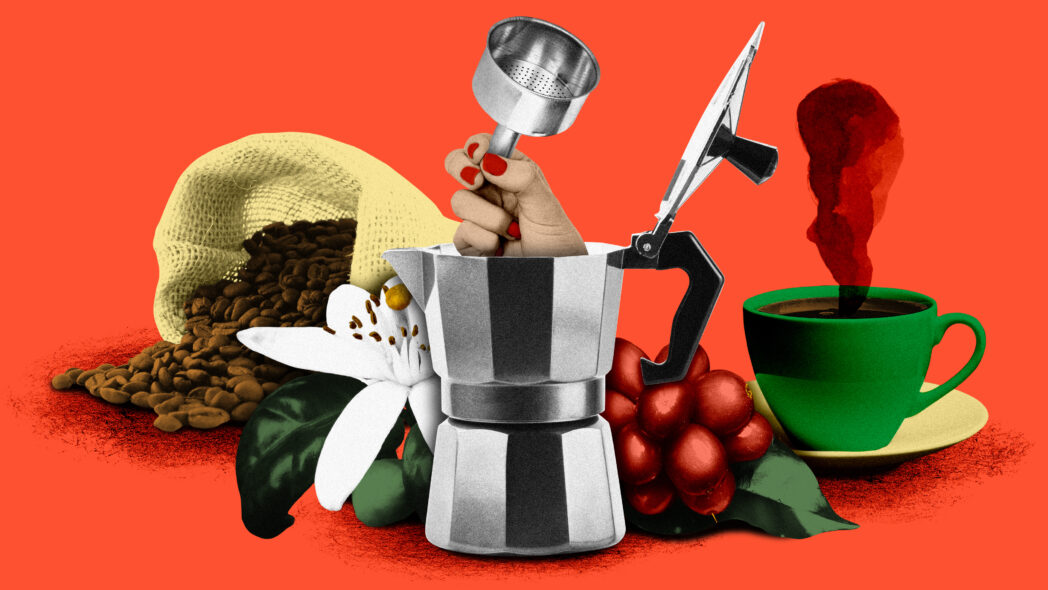#coffee #espresso #Italian
“In early 2022, Italy nominated its espresso culture to UNESCO’s list of Intangible Cultural Heritage of Humanity. But its under-sung, Zero-waste Moka pot is the real working hero of Italian coffee culture“–Paul Ebeling
Visitors to the Italy may pick up knowledge of its coffee rules of which there are many. However, it is the ubiquitous stovetop Moka pot, not pressurized espresso machines that is found in nearly every Italian home and typically the only way Italians make coffee themselves. In fact, market research suggests that 9 out of 10 Italian homes have a Moka pot.
The origins of the Moka pot, aka caffettiera in Italy are almost as murky and dark as the brew it produces. While it eventually became one of the beloved staples of la cucina Italiana, the original and patented Bialetti Moka Express was designed by Luigi di Ponti and manufactured by aluminum maker Alfonso Bialetti in Y 1933 during the height of Benito Mussolini’s power.
At that time, militarized Italy tightly controlled its imports and exports and relied solely on its rich sources of bauxite ore (necessary for aluminum), favored by the fascist regime over imported metals. This dovetailed nicely with Italy’s 1935 invasion and subsequent occupation of Abyssinia (modern-day Ethiopia) in Y 1935, which gave the regime unlimited access to coffee plantations, ensuring the caffeine-obsessed country an ample supply of beans and labor. This new patriotic pot was named after the Yemeni port city of Mocha, coffee’s cultural capital from the 16th to 19th centuries. And by the late 1940s, it could be found everywhere.
Since coffee has been consumed for millennia, several coffee makers preceded the Moka pot, including the Turkish Ibrik, a small copper or brass pot with a wooden handle dating back to the 16th century. Silver pots and linen sacks were used frequently in the 18th century. The enamel double-decker Mr. Biggin Pot was designed in France in Y 1780. But it really rose to prominence when Britain began taxing tea, kickstarting the American Revolution, and inadvertently creating what would become the world’s largest coffee-consumption market.
Meanwhile, in Italy, caffettiere culture started heating up.
The Neapolitan flip coffee pot, locally called the cuccumella, is believed by both coffee purveyors Lavazza and the Slow Food organization to come not from Naples at all but, rather, to have been invented and patented in y 1819 by Frenchman Jean-Louis Morize. It was called Neapolitan because he was in love with a Neapolitan woman. Naysayers, including coffee roaster Illy, assert it was invented 2 centuries earlier in Naples in Y 1691 by Jean Baptiste de Belloy. While the 19th century brought reunification in Italy, it did the opposite for coffee making, with the invention of the percolator and the French press. Drip-style coffee makers, paper coffee filters, and other brewing machines did not appear until the 20th century, long after the Moka pot claimed its dominance.
Bialetti’s original Moka Express model still dominates and still sports the l’omino coi baffi or “the mustachioed little man” logo, designed by comic artist Paul Campani in Y 1958 and emblazoned on the side of every model. Bialetti Industries. These include the Tricolore edition with the Italian flag’s colors and the green aluminum Break Alpina, paying homage to Alpini, the Italian Army’s mountain infantry, with a steep-roofed lid resembling a feathered cap.
In Y 2019, Italian design brand Alessi, run by Alfonso Bialetti’s maternal grandson Alberto Alessi and based in Piemonte revealed a svelte Moka pot designed by David Chipperfield at Paris’ Maison&Objet fair. They have also commissioned numerous designers including Richard Sapper, Piero Lissoni, and Michael Graves, to reinterpret the classic.
Illy, based in Italy’s coffee capital of Trieste, where coffee consumption is 2X that of the rest of the country, produced the Pulcina. Architect and designer Michele de Lucchi designed this plump, bulbous Moka pot with a red handle to resemble the beak of a chick. Architect Aldo Rossi’s iconic 1983 La Conica and 1990 La Cupola models are especially striking and sought out by collectors.
In Y 1979, Turin-based Lavazza hired architect Marco Zanuso to design a side-handled model dubbed Carmencita. At the Italian Pavilion of the Expo 2020 Dubai, they debuted the Solar Moka. This 8-foot-tall solar-powered Moka pot, suspended above the ground, doubled as the sustainable engine to power a waste-free Solar Coffee Garden.
Eat healthy, Be healthy, Live lively









